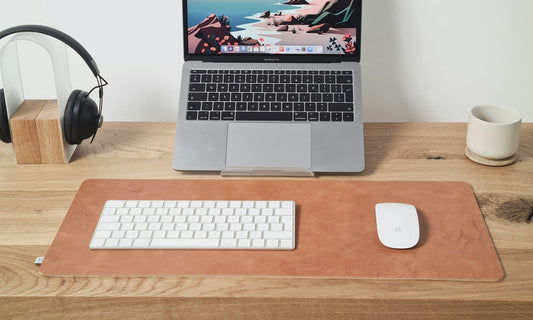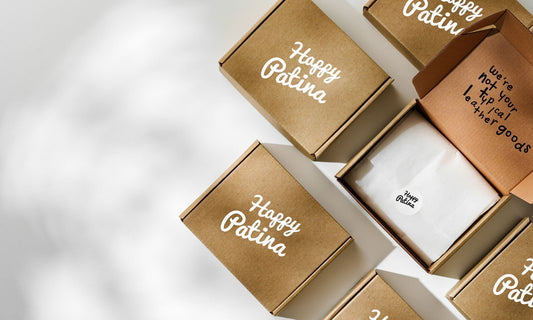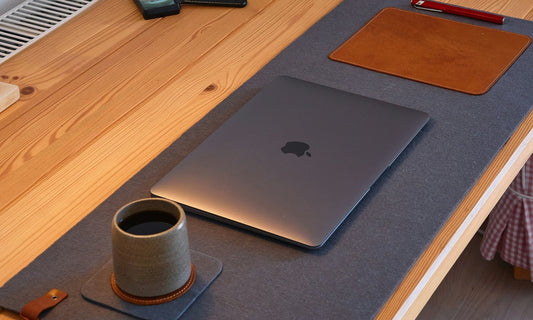
Every Object Has a Place: The Art of Quiet Organization
Oscar ArenasThere’s a calm that arises when everything in your workspace belongs exactly where it should. A sense of ease, rhythm, and quiet focus. This isn’t about sterile minimalism or rigid order — it’s about creating a space that feels intentional. At HappyPatina, we call it quiet organization: the balance between simplicity, beauty, and purpose.
In a world that moves too fast, your desk can be a small act of resistance — a place that helps you slow down, breathe, and think clearly. This guide explores how thoughtful organization can transform not just your workspace, but your mindset.
1. The Philosophy of Quiet Order
Most of us work surrounded by distractions: tangled cables, scattered papers, objects that demand attention instead of supporting it. But a well-organized workspace does more than look neat — it restores a sense of control and harmony. It invites focus.
Quiet organization is not about emptiness; it’s about balance. It’s the art of keeping only what adds value — aesthetically, functionally, or emotionally. When every object has meaning, even the smallest corner becomes purposeful.
Organization is not the absence of things; it’s the presence of clarity.
At HappyPatina, we believe your workspace should feel as crafted as the tools you use. A clean surface, warm materials, and objects designed to endure — these elements turn the act of working into a ritual, not a routine.
2. Start with the Surface
Your desk is more than a platform; it’s a reflection of your priorities. A cluttered surface equals a cluttered mind. Begin by removing everything, then add back only what serves your daily rhythm.
The Rule of Three
Keep no more than three functional objects within arm’s reach: your device, your notebook, and one tool for thinking — perhaps a pen or a cup of coffee. Everything else should live in drawers, trays, or folders.
Choose Natural Foundations
A leather desk pad creates a defined zone for focus, reducing visual noise and giving your desk tactile warmth. Its soft surface absorbs sound and movement, turning even the act of writing into a calming experience.
Surround it with contrast — wood, linen, or brass — materials that speak softly but add character. Avoid high-gloss finishes; matte textures absorb light and encourage stillness.
Your desk should invite you to work — not demand it.
3. Define Zones of Use
Every workspace, no matter how small, benefits from clear zones. These boundaries help your mind navigate between tasks effortlessly.
- Focus Zone: The area in front of you, free of clutter, reserved for deep work. Keep only your essentials here.
- Support Zone: To one side, a tray or folio for items in use — papers, notes, or tools you’ll return to later.
- Reset Zone: A space for end-of-day rituals: a place to put your phone, keys, or reminders for tomorrow.
Organization isn’t static; it’s a system that evolves with your habits. Revisit these zones weekly. Ask yourself: Does this belong here? If not, find its true place — or let it go.
4. Tools That Bring Calm
The best organizational tools are the ones you notice the least. They fade quietly into the background while doing their job beautifully.
Leather trays, cord tabs, and document folios embody this philosophy. They simplify without sterilizing, keeping order without suppressing warmth.
- Document Folio – Natural Leather — to keep notes and papers aligned, not scattered.
- Cord Tab – Natural Leather — to bring quiet discipline to your cables.
Good design makes space for you to think.
5. The Ritual of Resetting
Organization isn’t a one-time event — it’s a ritual. Ending each day by restoring order sets a rhythm that carries into the next morning.
Try This 5-Minute Routine:
- Clear the surface completely.
- Wipe gently with a soft cloth — removing dust, thoughts, and digital fatigue.
- Return objects to their place: notebook on tray, pen aligned, device closed.
- Look at your desk. It should feel like an exhale.
- Leave a single object to greet you tomorrow — a reminder of where to begin.
This brief act is more than cleaning. It’s a pause, a signal to your mind that work has ended and reflection can begin. Over time, this simple ritual trains focus as much as it maintains order.
6. Design That Supports Mindfulness
Quiet organization isn’t just aesthetic — it’s psychological. Visual clutter increases stress and drains energy. Minimalism done right, on the other hand, nurtures focus and creativity.
When you design your workspace with intention, you design your day. A space that feels peaceful encourages better decisions, deeper concentration, and greater appreciation for your tools.
Each HappyPatina object — from the Writing Kit Cover to the Document Folio — is made to support that mindset. They’re not decorations, but instruments of clarity.
When your environment is quiet, your thoughts become clear.
7. Small Gestures, Big Impact
Quiet organization doesn’t require redesigning your workspace — only rethinking how you use it. Start small:
- Align your tools at the end of each task.
- Fold papers once instead of stacking them.
- Dedicate a tray to things “in progress.”
- Replace visual clutter with tactile order — a coaster, a pad, a soft light.
- Turn off devices that don’t serve your focus.
Each micro-decision contributes to a larger sense of calm. Over time, your desk stops being a tool of productivity and becomes a space of restoration — where doing less leads to achieving more.
8. Beyond the Desk: A Philosophy of Space
The principles of quiet organization extend beyond work. They apply to your home, your routines, even your digital life. The same question always applies: Does this bring value, or does it take space?
When you design your surroundings intentionally, you align your inner and outer worlds. That’s the heart of A Life Well Crafted — thoughtful living through meaningful design.
Key Takeaways
- Quiet organization is about clarity, not emptiness.
- Every object should serve a function or bring calm.
- Define zones in your workspace for focus and flow.
- End each day with a brief ritual of resetting.
- Choose natural materials that age gracefully and soothe the senses.
FAQs
How can I organize my desk without making it feel sterile?
Use warm, natural materials like leather and wood to maintain a sense of texture and comfort. Balance visual simplicity with personal touches such as a photo, candle, or small plant.
What’s the best way to reduce distractions?
Keep only your current task visible. Store everything else in trays or drawers. Define a “reset” time daily to clear digital notifications and physical clutter together.
How often should I reorganize my workspace?
Once a week is ideal. Frequent small adjustments are better than occasional overhauls. Think of it as tuning an instrument — regular alignment keeps harmony.
Explore More Guides
- The Timeless Desk — How to Build a Workspace That Inspires You
- Leather vs Synthetic Desk Pads — Feel the Difference
- A Life Well Crafted — The Philosophy Behind HappyPatina
Final Thoughts
Every object deserves a place. When things are where they belong, attention flows effortlessly. The art of quiet organization is, at its core, the art of being present.
A well-ordered desk doesn’t just hold your work — it holds your state of mind. And when order meets beauty, routine becomes ritual.
Explore the Office Collection →



